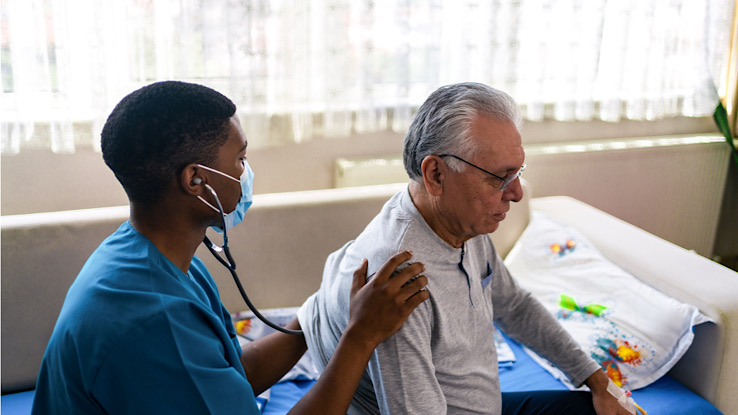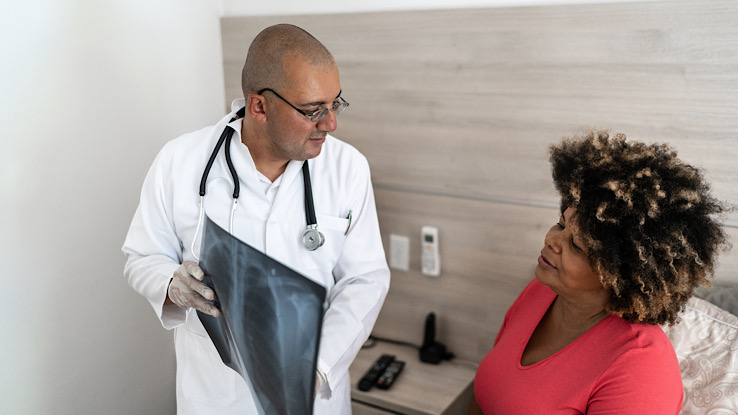What Is Nontuberculous Mycobacterial (NTM) Lung Disease?

What Is NTM Lung Disease?
Nontuberculous mycobacterial (NTM) lung disease is an infection caused by bacteria that live in soil and water worldwide. The bacteria can travel into your lungs on small pieces of dust, dirt, and drops of water when you breathe in air during your regular daily activities.
NTM can cause severe lung damage if it isn’t treated. It doesn’t affect most people unless they have another type of lung disease or condition, like emphysema and other chronic obstructive pulmonary diseases (COPD) or asthma.
NTM lung disease is not a common infection, even though most people have been exposed to the bacteria. More females and people older than 65 have been diagnosed with NTM lung disease, and you can’t catch it from a person that has the infection.
This article will tell you more about NTM lung disease symptoms, risk factors, diagnosis, and treatment.
What Does NTM Mean?
NTM includes a group of several bacteria (germs) that belong to the same family as tuberculosis, called Mycobacteria. The mycobacteria include tuberculosis or TB. This contagious lung infection spreads easily, from an infected person to others. “Nontuberculous” means that NTM doesn’t cause TB, but involves a related germ from the Mycobacteria family. NTM can cause severe lung infections in some people and is hard to treat. Thankfully, it doesn’t cause infection or symptoms in most people.
NTM Lung Disease Symptoms
NTM lung disease usually doesn’t cause symptoms immediately after exposure. Many people have the bacteria in their bodies for months or years before they notice symptoms.
It’s hard to tell if NTM causes lung disease symptoms since they look like symptoms caused by other conditions that cause problems in your lungs. It can cause permanent lung damage if it isn’t treated.
Common symptoms of NTM lung disease are:
- Feeling tired
- Coughing
- Fever
- Shortness of breath
- Weight loss
- Coughing blood
- Chest pain
Coughing causes helpful cells from your immune system to try and surround NTM bacteria and get them out of your body. When NTM bacteria can avoid /this process, your immune cells might start to clump. This can make you cough more, cause your lungs to work harder, and make it difficult for you to breathe.
NTM bacteria don’t cause infections or symptoms in most people unless you have other lung diseases or conditions that weaken your immune system. People with lung damage caused by other health conditions can have difficulty clearing NTM bacteria from their lungs.
Risk Factors
- Frequent pneumonia
- CiOPD, including emphysema
- Bronchiectasis
- Asthma
- Cystic fibrosis
- People with health conditions like HIV or rheumatoid arthritis or taking medication that weakens the immune system
Bronchiectasis is a lung condition that usually happens after an infection has begun and makes it hard for people to cough out a thick liquid called mucus, or phlegm. The mucus builds up in your lungs and can become filled with bacteria, which may cause more severe infection and damage to the lungs and airways (tubes) that branch off your lungs.
Bronchiectasis can make it easier for NTM bacteria to infect the lungs without being noticed. It’s challenging to treat and has no cure.
Causes
Most people have been around the bacteria that cause NTM because it can be found in the environment worldwide. When you breathe, NTM bacteria can get inside your lungs and stay for days, months, or years.
NTM bacteria live in:
- Soil on the ground, in yards, parks, and gardens
- Rivers, lakes, and streams
- Tap water, including steam or mist from showers and baths, or washing dishes
- Steam from bathtubs
Unfortunately, there isn’t a way to prevent exposure to NTM because the bacteria are commonly found outdoors and inside water pipes. Cleaning products and disinfectants may not get rid of NTM bacteria, and they are resistant to high temperatures.
How is NTM Lung Disease Diagnosed?

NTM lung disease is difficult to diagnose because people that are infected usually have other health problems that cause the same symptoms. Your doctor might ask questions about your symptoms and check your body for signs of lung illness by ordering tests. Your doctor may order tests to check for NTM bacteria in your body and to see images showing the size and condition of your lungs and airways.
These are some of the tests your doctor might use to diagnose NTM lung disease:
- Sputum (mucus) culture, to check for NTM bacteria
- Chest x-ray, or CT scan, to look at images of your lungs and airways
- Lung biopsy, to remove a small sample of your lung tissue, to look for NTM bacteria through a microscope
Treatment for NTM Lung Disease
Your doctor will discuss different treatment options for NTM lung disease based on other health conditions you have and how you are feeling with your current symptoms. NTM infection is difficult to treat with medicine because it is resistant to many drugs, and it can take a long time to get rid of.
NTM lung disease treatment could include:
- Long-term antibiotics, taken for up to 1 year
- Breathing treatments with saline (salt water) to help you cough up the mucus clogging your lungs
- Lung surgery to remove damaged sections
Treatment for NTM lung disease is a long process. Your doctor will continue to check for changes or improvements and watch for possible side effects caused by the treatment drugs.
Next Steps: When to See a Doctor for Symptoms
NTM symptoms can feel like other lung conditions, like asthma or COPD. The bacteria stay in your body for months or years. This makes it harder to know if the symptoms are from a condition you already have, but you can look for some signs that are different from how you usually feel.
So, when should you talk to your doctor about NTM lung disease?
Contact your doctor if you have lung disease or a condition that makes it harder to breathe and these symptoms or situations:
- Coughing that doesn’t go away and seems to get worse. It can be dry or wet with mucus, making it hard for you to sleep.
- Feeling tired and having trouble breathing normally when doing everyday things, like walking up the stairs.
- Having to use your inhaler more often than usual to help you breathe.
- Waking up sweaty at night, with chills and a low fever.
- Losing weight unexpectedly because you don’t feel like eating.
- You have had pneumonia or another lung infection several times.
- Medicine that you have been taking to treat coughing, shortness of breath, and tiredness didn’t help you feel better.
- Coughing up blood
Coughing up blood is always an emergency. You should see your doctor or go to the emergency room as soon as possible.
Living with NTM Lung Disease
NTM lung disease can cause symptoms that make it harder to do things you usually do every day. Here are some steps you can take to feel better and prevent its effects.
- Stop smoking if you do.
- Exercise by walking, doing yoga, or other light physical arctivities
- Stay up to date with vaccines for flu and pneumonia
- Try to avoid moisture from saunas and hot tubs
- Eat healthy foods to help keep your body strong and fight infections.
Resource Links:
- “Nontuberculous Mycobacteria (NTM) Infections” via Centers for Disease Control and Prevention (CDC)
- “Learn about NTM Lung Disease” via American Lung Association
- “What is Nontuberculous Mycobacteria (NTM) Lung Disease?” via American Thoracic Society
- “Nontuberculous Mycobacterial Lung Disease” via National Organization for Rare Disorders
- “Nontuberculous Mycobacterial Infections” via JAMA
- “Mycobacterial Infections” via MedlinePlus
- “NTM Lung Disease” via Cleveland Clinic
- “An Official ATS/IDSA Statement: Diagnosis, Treatment, and Prevention of Nontuberculous Mycobacterial Diseases” via American Journal of Respiratory and Critical Care Medicine
- “Tuberculosis” via MedlinePlus
- “What is Bronchiectasis?” via National Heart, Lung and Blood Institute/NIH





